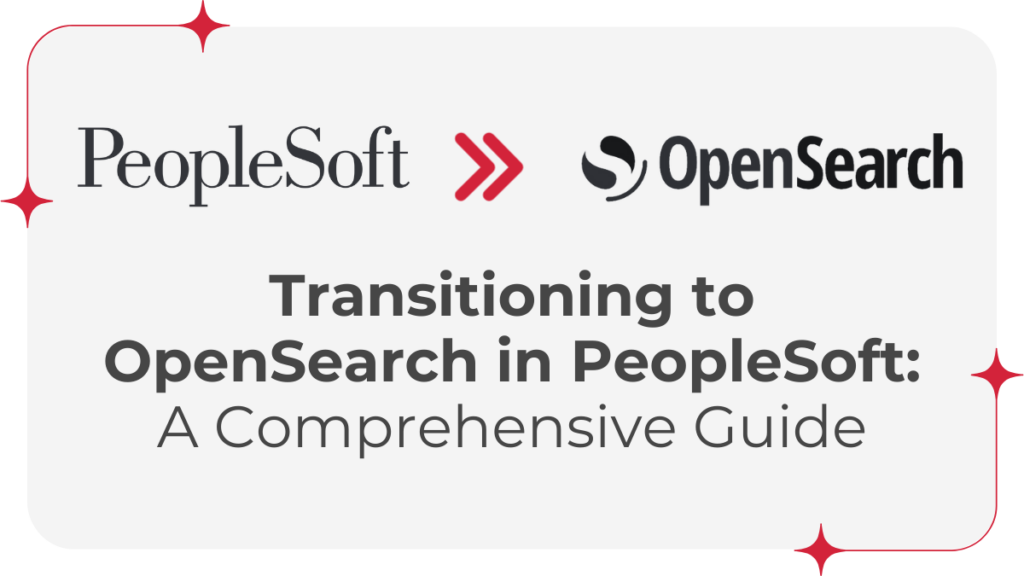
A Comprehensive Guide
Migrating from Elasticsearch to OpenSearch in PeopleSoft is an important step in maintaining the OpenSource project status while still delivering best in class Apache Lucine Search capabilities. Driven by Oracle’s recent updates, the Elasticsearch to OpenSearch migration is not merely a response to licensing changes but an opportunity to enhance search functionality with minimal disruption. Let’s explore the intricacies of this transition, focusing on the technical components and the practical steps required to navigate the change effectively.
Understanding the Transition: Elasticsearch to OpenSearch
The shift from Elasticsearch to OpenSearch in PeopleSoft is primarily driven by licensing changes introduced by Elastic, prompting Oracle to adopt OpenSearch as the successor. This transition began with the PeopleTools 8.60.07 and 8.59.21 patches, representing a move to a secure, high-quality, fully open-source search and analytics platform.
For most users, the impact of this transition will be minimal. PeopleSoft Search with OpenSearch and OpenSearch Dashboards will appear almost identical to its predecessors, Elasticsearch and Kibana. However, system administrators must be aware of several key technical points to ensure a smooth transition.
Key Improvements in PeopleSoft Search and Insights

PeopleSoft OpenSearch Process Elements
The transition to OpenSearch introduces several enhancements to PeopleSoft Search and Insights. These improvements are not only easy to implement but also significantly enhance the user experience:
- Seamless Deployment Using DPK: OpenSearch can be deployed seamlessly using the Deployment Package Kit (DPK), allowing for a streamlined installation process that ensures compatibility with PeopleSoft environments
- Highly Available Indexes: OpenSearch supports the deployment of highly available indexes with scalable failover options. This ensures that your search infrastructure remains robust and resilient, even under heavy load
- Enhanced Search and Crawl Speed: OpenSearch offers excellent performance in terms of crawl and search speed, providing faster and more efficient data retrieval
- Efficient Data Storage and Indexing: JSON files are stored across nodes, and indexes are based on an Inverted Index and Term Frequency (TF). Shards holding Lucene segments are distributed across nodes, optimizing search operations
- BM25 Similarity Module: OpenSearch employs the BM25 similarity module, an improvement over the traditional TF-IDF algorithm. BM25 considers field length and applies term frequency saturation, offering more relevant search results
- PeopleSoft Insights: With over 400 delivered visualizations, PeopleSoft Insights offers a robust platform for data exploration and analysis. The alignment between Classic and Fluid component search provides a consistent user experience, and real-time indexing (RTI) ensures that search results are always up to date
OpenSearch Landscape: A Technical Overview
OpenSearch introduces a comprehensive landscape for managing search and analytics in PeopleSoft:
- OpenSearch Core: OpenSearch holds JSON documents and handles search and ingestion operations. It coordinates shards, failovers, and the master node, ensuring data integrity and high availability
- OpenSearch Dashboards (Insights): This component allows for visualization and discovery of data, providing a console to interface with your data seamlessly
- Logstash: Responsible for the ingestion of external data, Logstash also handles data transformations, ensuring that all incoming data is properly formatted and indexed within OpenSearch
Relational Databases vs. OpenSearch: A Comparison
Understanding the difference between traditional relational databases and OpenSearch is crucial for system administrators:
- Relational Databases: Utilize a relational model where data is stored in tables with rows and columns. Relationships between tables are maintained using primary and foreign keys, making it ideal for structured data storage and transactional operations
- OpenSearch: Stores data in JSON format as documents within indices. It excels in full-text search and analytics, offering advanced search capabilities that are more suited to unstructured or semi-structured data
The Migration Process: Steps to Move to OpenSearch
Migrating to OpenSearch involves a few key steps that ensure a smooth transition:
- Install OpenSearch: Use the OSK DPK to install OpenSearch and perform a full data copy from Elasticsearch.
- Configure OpenSearch: To begin the OpenSearch config process, create a new search instance within OpenSearch and clone the deployment data using the ‘Copy Deployment Data’ button.
- Validate the Migration: Perform validations using dedicated users to ensure everything functions as expected.
- Switch to OpenSearch: Transition the primary instance to OpenSearch and restart the process scheduler, allowing the RTI service to pick up the changes.
- Post-Migration: Apply necessary application updates or PRPs via PUM and monitor the system for any issues.
OpenSearch Dashboards: What’s New?
OpenSearch Dashboards bring a few changes that users should be aware of:
- Region Maps: OpenSearch Dashboards use the OpenSearch maps service, which differs slightly from Kibana’s Elastic Maps Service. While the FIPS 5-2 alpha code and postcode are not available, custom vector options using GeoJSON are limited to 25 MB in size and 10,000 features.
These differences, though minor, are essential to note for those heavily relying on mapping features within PeopleSoft.
PeopleSoft to OpenSearch Architecture: Security Plug-in Integration

PeopleSoft OpenSearch User Security and Semi Architecture
A key aspect of the OpenSearch architecture in PeopleSoft is the integration of security plug-ins. When a user attempts to view a dashboard or visualization, the security plug-in module is invoked from PeopleSoft Insights. This module performs a callback with user credentials to the search engine, which then communicates with the PeopleSoft Security Service (a Web service) to authorize the user and retrieve their security attributes.
Key Takeaways: Why Migrating to PeopleSoft OpenSearch is Essential
Transitioning to OpenSearch addresses licensing changes and aims to future-proof your PeopleSoft environment. OpenSearch is a solid, open-source solution that works well with existing PeopleSoft tools, allowing your organization to maintain effective search and analytics capabilities without disruption.
What’s Next?
Are you ready to migrate from Elasticsearch to OpenSearch? Migrating to OpenSearch in PeopleSoft is a crucial step for any organization using PeopleTools 8.60.07 and beyond. With Oracle’s support and the benefits of a secure, open-source platform, this change is both necessary and advantageous. Take full advantage of one of the best open source search engine platforms! Follow the steps outlined in this guide to ensure a smooth transition that enhances search functionality and improves the overall user experience.
To learn more about PeopleSoft OpenSearch, contact [email protected] or check out our PeopleSoft Services page. If you’re looking for monthly updates on PeopleSoft changes, subscribe to Elire’s Monthly PeopleSoft Newsletter to never miss a beat. In addition, follow Elire on LinkedIn and receive industry updates directly to your phone.
-

Valentin Todorow
Automated Testing Focus Lead Valentin Todorow has over 12 years of PeopleSoft Technical and Functional experience and has completed over 80 Implementations of PTF in FSCM and HCM. He has built various integrations with other Test Management tools, Designed and Developed bolt-ons for PTF reporting, and headless execution.
Author
-

Mrs. Selness serves as Elire’s Marketing Specialist, working to develop and optimize marketing brand assets. Jordan collaborates with the Elire Team to produce blog and social media content, strategize for social media expansion, and maintain Elire’s internal and external branding.
View all posts
